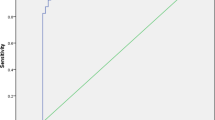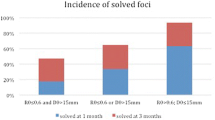Abstract
Objectives
The diagnosis of acute pyelonephritis (APN) requires demonstration of parenchymal involvement. When no predisposing conditions are found, non-complicated APN is suspected and CT or MRI should be performed. Diffusion-weighted (DW) MRI might be useful, quicker and cheaper than the standard gadolinium-enhanced (GE) MRI. The aim of this study is to compare DW-MRI with GE-MRI to test its diagnostic accuracy in APN.
Methods
Of 318 consecutive patients hospitalised for APN, 279 underwent MRI. Four hundred and fourteen MR studies (first test and follow-up examinations) were gathered and data were processed using Diffusion Analysis software. DW-MRI has been compared with GE-MRI for evaluating diagnostic agreement.
Results
Two hundred and forty-four patients were diagnosed as having APN; 35 were negative. One hundred and sixty-three APN cases were considered non-complicated and selected for the study. Among the 414 MR examinations, comparing DW-MRI with GE-MRI, positive correlation was found in 258 cases, negative in 133. There were 14 false-negatives and 9 false-positives. DW-MRI achieved sensitivity 95.2 %, specificity 94.9 %, positive predictive value 96.9 %, negative predictive value 92.3 % and accuracy 94.6 %.
Conclusions
DW-MRI is reliable for diagnosing non-complicated APN. The high diagnostic agreement between DW-MRI and GE-MRI offers new perspectives in diagnostic management, enabling diagnosis of non-complicated APN without using ionising radiation or contrast media.
Key Points
• The diagnosis of acute pyelonephritis (APN) requires demonstration of renal involvement.
• Hitherto magnetic resonance imaging required gadolinium enhancement (GE-MRI) to establish this diagnosis.
• But diagnostic agreement between diffusion-weighted and GE-MRI offers new diagnostic opportunities.
• Quantification of ADC values can help diagnose and monitor APN.
• DW-MRI avoids ionising radiation and paramagnetic contrast medium administration.





Similar content being viewed by others
References
Hooton TM, Stamm WE (1997) Diagnosis and treatment of uncomplicated urinary tract infection. Infect Dis Clin North Am 11:551–581
Georgi A, Reddy YNV, Gautam G (2012) Diagnosis of acute pyelonephritis with recent trends in management. Nephrol Dial Transplant 27:3391–3394
Ramakrishnan K, Schedi DC (2005) Diagnosis and management of acute pyelonephritis in adults. Am Fam Physician 71:933–942
Medical Research Council Bacteriuria Committee (1979) Recommended terminology of urinary tract infection: a report by the members of Medical Research Council Bacteriuria Committee. Br Med J 2:717–719
Talner LB, Davidson AJ, Lebowitz RL, Dalla Palma L, Goldman SM (1994) Acute pyelonephritis: can we agree on terminology? Radiology 192:297–305
Dyer RB (1997) CT of renal inflammatory disease. Invited commentary. Radiographics 17:867–868
Soulen MC, Fishman EK, Goldman SM, Gatewood OM (1989) Sequelae of acute renal infection: CT evaluation. Radiology 173:423–426
Webb JAW (1987) The role of imaging in adult acute urinary tract infection. Eur Radiol 7:837–843
Gupta K, Hooton TM, Naber KG et al (2011) International clinical practice guidelines for the treatment of acute uncomplicated cystitis and pyelonephritis in women: a 2010 update by the Infectious Diseases Society of America and the European Society for Microbiology and Infectious Diseases. Clin Infect Dis 52:103–120
Parenti GC, Passari A (2001) Pielonefrite acuta: ruolo della diagnostica per immagini. Radiol Med 101:251–254
Craig WD, Brent JW, Travis MD (2008) From the archives of the AFIP, pyelonephritis: radiologic-pathologic review. Radiographics 28:255–276
Majd M, Nussbaum Blask AR, Markle BM et al (2001) Acute pyelonephritis: comparison of diagnosis with 99mTc-DMSA, SPECT, spiral CT, MR imaging, and power Doppler US in an experimental pig model. Radiology 218:101–108
Piccoli GB, Consiglio V, Deagostini MC et al (2011) The clinical and imaging presentation of acute “non complicated” pyelonephritis, a new profile for an ancient disease. BMC Nephrol 12:68–78
Martina MC, Campanino PP, Caraffo F et al (2010) Dynamic magnetic resonance imaging in acute pyelonephritis. Radiol Med 115:287–300
Nikken JJ, Krestin GP (2007) MRI of the Kidney: state of the art. Eur Radiol 17:2780–2793
Hagmann P, Jonasson L, Maeder P, Thiran JP, Wedeen VJ, Meuli R (2006) Understanding diffusion MR imaging technique. Radiographics 26:S205–S223
Kawashima A, Sandler CM, Goldman SM (2000) Imaging in acute renal infection. BJU Int 86:70–79
Johansen TE (2004) The role of imaging in urinary tract infections. World J Urol 22:392–398
Muller MF, Prasad PV, Bimmler D, Kaiser A, Edelman RR (1994) Functional imaging of the kidney by means of measurement of the apparent diffusion coefficient. Radiology 193:711–715
Chow LC, Bammer R, Moseley ME, Sommer FG (2003) Single breath-hold diffusion-weighted imaging of the abdomen. J Magn Reson Imaging 18:377–382
Thoeny HC, De Keyzer F, Oyen RH, Peeters RR (2005) Diffusion-weighted MR imaging of kidneys in healthy volunteers and patients with parenchymal diseases: initial experience. Radiology 235:911–917
Xu Y, Wang X, Jiang X (2007) Relationship between the renal apparent diffusion coefficient and glomerular filtration rate: preliminary experience. J Magn Reson Imaging 26:678–681
Carbone SF, Gaggioli E, Ricci V, Mazzei F, Mazzei MA, Volterrani L (2007) Diffusion-weighted magnetic resonance imaging in the evaluation of renal function: a preliminary study. Radiol Med 112:1201–1210
Pennigton DJ, Lonergan GJ, Flack CE, Waguespeck RL, Jackson CB (1996) Experimental pyelonephritis in piglets: diagnosis with MR imaging. Radiology 201:199–205
Kovanlikaya A, Okkay N, Cakmakci H, Ozdoðan O, Degirmenci B, Kavukcu S (2004) Comparison of MRI and renal cortical scintigraphy findings in childhood acute pyelonephritis: preliminary experience. Eur J Radiol 49:76–80
Israel GM (2006) MRI of the kidney and urinary tract. J Magn Reson Imaging 24:725–734
SIRM-SIN-AINR (2007) Fibrosi nefrogenica sistemica. Raccomandazioni per l’uso degli agenti di contrasto a base di Gadolinio. http://www.sirm.org e www.sin-italy.org. Accessed 30.10.2007
Sadowski EA, Bennett LD, Chan MR et al (2007) Nephrogenic systemic fibrosis: risk factors and incidence estimation. Radiology 243:148–157
Arlinghaus LR, Li X, Levy M et al (2010) Current and future trends in magnetic resonance imaging assessments of the response of breast tumors to neoadjuvant chemotherapy. J Oncol 2010
Eccles CL, Haider EA, Haider MA, Fung S, Lockwood G, Dawson LA (2009) Change in diffusion weighted MRI during liver cancer radiotherapy: preliminary observations. Acta Oncol 48:1034–1043
Namimoto T, Yamashita Y, Mitsuzaki K, Nakayama Y, Tang Y, Takahashi M (1999) Measurement of the apparent diffusion coefficient in diffuse renal disease by diffusion weighted echo-planar MR imaging. J Magn Reson Imaging 9:832–837
Cova M, Squillaci E, Stacul F et al (2004) Diffusion-weighted MRI in the evaluation of renal lesions: preliminary results. Br J Radiol 77:851–857
Squillaci E, Manenti G, Di Stefano F, Miano R, Strigari L, Simonetti G (2004) Diffusion-weighted MR imaging in the evaluation of renal tumours. J Exp Clin Cancer Res 23:39–45
Zhang J, Tehrani YM, Wang L, Ishill NM, Schwartz LH, Hricak H (2008) Renal masses: characterization with diffusion-weighted MR imaging-a preliminary experience. Radiology 247:458–464
Palmucci S, Mauro LA, Veroux P et al (2011) Magnetic resonance with diffusion-weighted imaging in the evaluation of transplanted kidneys: preliminary findings. Transplant Proc 43:960–966
Taouli B, Thakur R, Mannelli L et al (2009) Renal lesions: characterization with diffusion-weighted imaging versus contrast-enhanced MR imaging. Radiology 251:398–407
Kim S, Jain M, Harris AB et al (2009) T1 Hyperintense renal lesions: characterization with diffusion weighted MR imaging versus contrast-enhanced MR imaging. Radiology 251:796–807
Macarini L, Stoppino LP, Milillo P, Ciuffreda P, Fortunato F, Vinci R (2010) Diffusion-weighted MRI with parallel imaging technique: apparent diffusion coefficient determination in normal kidneys and in non malignant renal diseases. Clin Imaging 34:432–440
Colagrande S, Belli G, Politi LS, Mannelli L, Pasquinelli F, Villari N (2008) The influence of diffusion and relaxation-related factors on signal intensity: an introductive guide to magnetic resonance diffusion-weighted imaging studies. J Comput Assist Tomogr 32:463–474
Colagrande S, Carbone SF, Carusi LM, Cova M, Villari N (2006) Magnetic resonance diffusion-weighted imaging: extraneurological applications. Radiol Med 111:392–419
Fukuda Y, Ohashi I, Hanafusa K et al (2000) Anisotropic diffusion in kidney: apparent diffusion coefficient measurements for clinical use. J Magn Reson Imaging 11:156–160
Mürtz P, Flacke S, Träber F, Van den Brink JS, Gieseke J, Schild HH (2002) Abdomen: diffusion-weighted MR imaging with pulse-triggered single-shot sequences. Radiology 224:258–264
Author information
Authors and Affiliations
Corresponding author
Rights and permissions
About this article
Cite this article
De Pascale, A., Piccoli, G.B., Priola, S.M. et al. Diffusion-weighted magnetic resonance imaging: new perspectives in the diagnostic pathway of non-complicated acute pyelonephritis. Eur Radiol 23, 3077–3086 (2013). https://doi.org/10.1007/s00330-013-2906-y
Received:
Revised:
Accepted:
Published:
Issue Date:
DOI: https://doi.org/10.1007/s00330-013-2906-y




